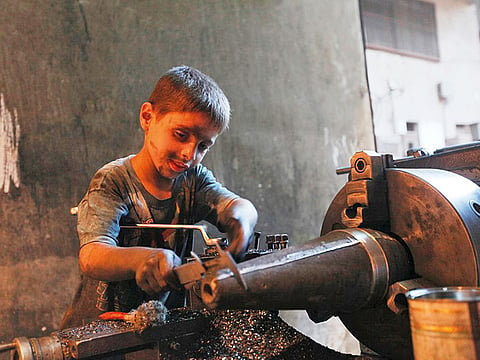Regional spike in child labour amid global low
War, displacement, and poverty are the main factors forcing the young to take up work and rendering them vulnerable to abuse and exploitation

Dubai: As child labour around the world has been steadily decreasing over the years — thanks to sustained efforts by rights groups and governments to clamp down on the phenomenon — conflicts in the Middle East have contributed to a spike in child labour.
According to the latest International Labour Organisation (ILO) report issued in 2015, some 168 million children around the world have been trapped in child labour, with 85 million of them involved in hazardous occupations.
With International Day Against Child Labour being observed on Monday, rights groups have applauded the fact that child labour around the world has declined by about one-third.
According to the International Labour Organisation, there are 9.2 million child labourers in the Middle East (8.4 per cent of the global total).
The six-year war in Syria has had huge ramnifications as more than 465,000 have been killed and millions of refugees have either left the country or have been internally displaced.
As a result, thousands of Syrian children have become farm labourers — the destitution resulting from their displacement prompting them to enter a workforce where they are vulnerable to abuse and exploitation. Many skip school to provide for their families, often hustled into adulthood before their time.
Street children are a fixture in the Lebanese capital Beirut, hawking goods, begging, shining shoes and selling flowers at night to bar customers, risking the occasional beating and frequent verbal abuse. Most sleep rough and some turn to prostitution, the highest-paid occupation in local child labour.
Around 2.7 million Syrian children are currently out of school, according to a recent joint report on child labour from Save the Children and Unicef.
Nearly half of Syrian refugee households in Jordan say they rely partly or entirely on children’s income. But the children risk health problems and psychological distress, the report says — three-quarters of working children in Jordan’s Zaatari refugee camp reported poor health, and 36 per cent of working children in Lebanon’s Bekaa Valley are illiterate.
In Yemen, which has been embroiled in war for over two years, many children have been recruited by Iran-backed Al Houthi militants as child soldiers.
According to a 2015 report, about 14 per cent of children aged between 5 to 14 years are involved in child labour while approximately 10 per cent of children aged 7 to 14 manage to go to school and work at the same time.
“War, displacement, and poverty are the main agents behind exacerbation of child labour. Since many families have not received salaries for months or lost their breadwinners, they are forced into sending their children out to work in laborious jobs. But in my opinion, Al Houthi recruitment of children is the worst factor. They recruit young people and send them to the battleground,” Ali Al Sarari, an activist from Seyaj, a leading NGO that advocates for child protection, told Gulf News
And in Gaza, child labour has shown an upward trend with 9,700 children slogging it out, according to the Palestinian Bureau of Statistics.
With the world’s highest unemployment rate of 43 per cent, and 80 per cent of the population dependent on foreign aid, 2,900 children below the legal employment age of 15 have become their families’ breadwinners.
Children are often seen roaming the streets selling odd items — from combs, to batteries, to candy.
On a street corner in the Deir Al Balah neighbourhood, 12-year-old Mahmoud Abu Amra and his brother Mohammad, 13, work nearly eight hours a day for a measly $6.
“I wish I could spend my time playing with the other kids, but my family depends on my earings to survive,” Mahmoud told Gulf News.
And in Egypt — the Arab world’s most populous country of 93 million people — the situation worsened after the government floated its local currency and cut fuel subsidies as part of tough economic reforms.
This resulted in an increase in child workers in Egypt, which was estimated at 1.6 million, with more than 80 per cent of them in rural areas, according to official figures. However, non-governmental groups say the number is closer to 3 million.
Yousuf Samir, a seventh grader, works during the summer at a carpentry workshop in northern Cairo earning around 30 Egyptian pounds (Dh6) a day.
“I work to help my family because my father is ill with a liver disease and can’t work regularly,” the 13-year-old said.
Sign up for the Daily Briefing
Get the latest news and updates straight to your inbox



